| There are several parts of the minting
process that could account for the sharpness, or lack thereof, of a coin's
strike. The most important aspect is striking pressure. Striking pressure
can vary tremendously from coin to coin during the minting process. In
fact, some mints (particularly New Orleans, Charlotte and Dahlonega) were
usually allocated the poorer condition presses and dies. Therefore these
mints tended to produce a worse than average coin in terms of strike. In
addition, the sharpness of the die needs to be considered. This may vary
due to wear on the die, or on the master die from which the die itself
is made. Finally, the consistency and quality of the planchet can affect
the quality of strike.
Below is a photograph of a fully
struck mint state Morgan dollar:
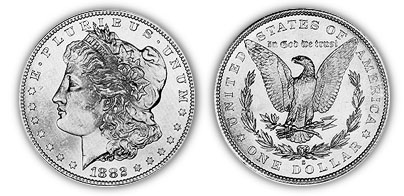
Below are photographs of fully struck
examples of some of the various sub-types of Morgan dollars, which show
slightly different die characteristics:
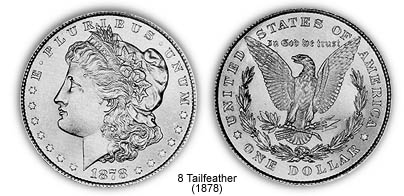
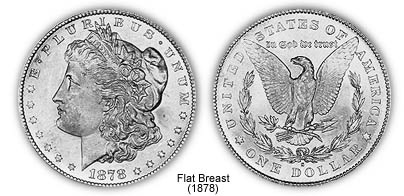
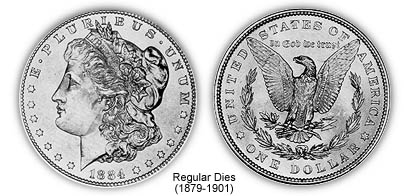
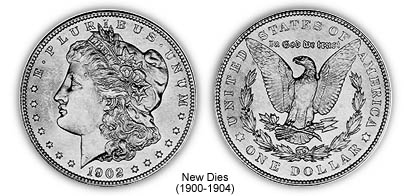
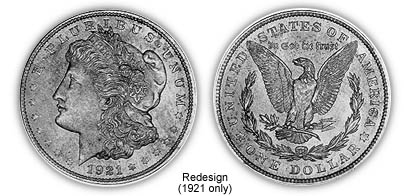
It is important to note that Morgan dollars
dated prior to 1879 (including some varieties of 1879-S) and after 1899,
simply do not have all the same die details as most Morgan dollars. This
variation in no way prevents those coins from being considered fully struck,
as long as they possess all the details of their particular sub-type.
Here are photographs of mint
state examples of the 1879-1899 sub-type, graded by strike, 1 through 5:
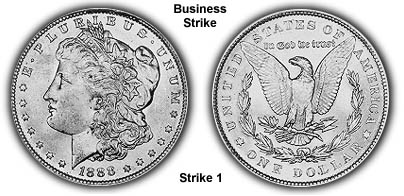
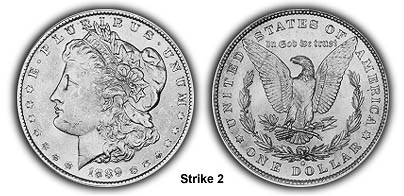
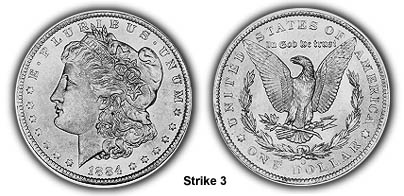
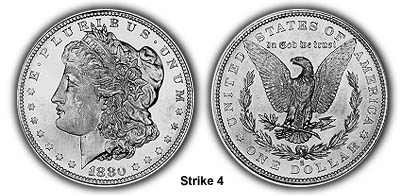
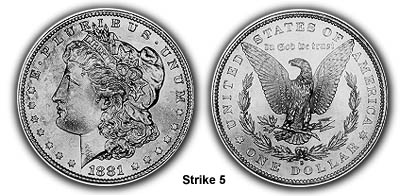
Note that any coin struck with less detail
than the coin in photo #1 must have the weakness of strike somehow noted
in its final overall grade description. (For example: MS-63, weakly struck,
or MS-60, typical strike for this notoriously weak date.)
Here are photographs of proof
examples of the 1879-99 sub-type, graded by strike, 1 through 5:
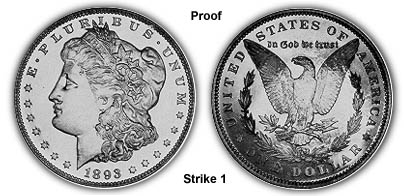
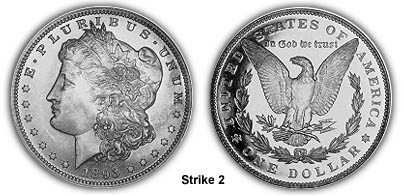
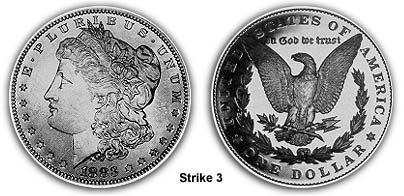
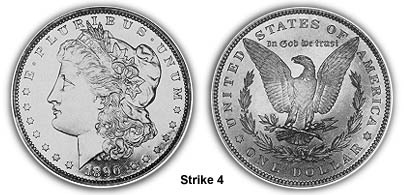
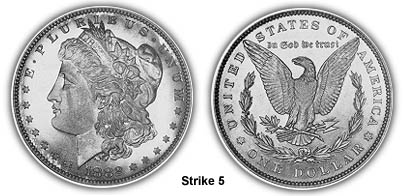
Again, any coin weaker than photo #1 (regardless
of how poorly or well struck that particular issue is normally found) must
have the strike mentioned in its overall grade description. Even if this
is the case, you should still use the strike grade "1" when calculating
the overall grade.
Feel free to use intermediate
grades (such as 3-1/2 or 2.6) when evaluating strike. Also, keep in mind
that a coin might have more details than the corresponding photograph in
some areas and less details in other areas. Occasionally, a coin may have
weakness about the periphery (the outer areas). A good rule of thumb is
that it is only about a third (1/3) as detrimental for a coin to lack peripheral
detail as it is for the coin to lack the same amount of detail in the central
portion.
Here is a brief synopsis of the
striking characteristics of each date and mint mark of Morgan dollar:
STRIKE
| 1878
8 TF - |
Above
average to bold. |
1891
P - |
Most
weak. |
| 1878
7/8 TF - |
Average. |
1891
O - |
Typically
soft and weak. |
| 1878
7 TF - |
Above
average. |
1891
S - |
Variable,
but most are sharp. |
| 1878
7TF RB - |
Sharp
and bold. |
1891
CC - |
Above
average. |
| 1878
S - |
Sharp
and bold. |
1892
P - |
Many
weak, but variable. |
| 1878
CC - |
Sharp
and bold. |
1892
O - |
Almost
always weak and soft. |
| 1879
P - |
Variable,
but generally average. |
1892
S - |
Sharp
and well struck. |
| 1879
O - |
Average
to above average. |
1892
CC - |
Above
average. |
| 1879
S - |
Sharp
and bold. |
1893
P - |
Average
to above average. |
| 1879
CC - |
Average. |
1893
O - |
Typically
weak. |
| 1880
P - |
Average
to above average. |
1893
S - |
Sharp
when found. |
| 1880
O - |
Variable,
but generally strong. |
1893
CC - |
Most
are weak, especially P-L's. |
| 1880
S - |
Sharp
and bold. |
1894
P - |
Usually
well struck. |
| 1880
CC - |
Above
average to bold. |
1894
O - |
Generally
quite soft. |
| 1881
P - |
Above
average. |
1894
S - |
Sharp
and bold. |
| 1881
O - |
Average. |
1895
O - |
Weak
and soft. |
| 1881
S - |
Sharp
and bold. |
1895
S - |
Above
average. |
| 1881
CC - |
Sharp
and bold. |
1896
P - |
Sharp
and bold. |
| 1882
P - |
Above
average. |
1896
O - |
Weak
and soft. |
| 1882
O - |
Average. |
1896
S - |
Usually
average. |
| 1882
S - |
Sharp
and bold. |
1897
P - |
Generally
sharp. |
| 1882
CC - |
Above
average. |
1897
O - |
Average,
though some weak. |
| 1883
P - |
Above
average. |
1897
S - |
Above
average. |
| 1883
O - |
Average
to a bit soft. |
1898
P - |
Sharp
and bold. |
| 1883
S - |
Sharp
and bold. |
1898
O - |
Above
average. |
| 1883
CC - |
Above
average, to bold. |
1898
S - |
Average
to above average. |
| 1884
P - |
Above
average to bold. |
1899
P - |
Above
average to bold. |
| 1884
O - |
Soft
to average. |
1899
O - |
Above
average to bold. |
| 1884
S - |
Above
average. |
1899
S - |
Above
average. |
| 1884
CC - |
Above
average to bold. |
1900
P - |
Average. |
| 1885
P - |
Above
average. |
1900
O - |
Average. |
| 1885
O - |
Variable,
but usually average. |
1900
S - |
Average. |
| 1885
S - |
Average. |
1901
P - |
Generally
weak and soft. |
| 1885
CC - |
Above
average to bold. |
1901
O - |
Average. |
| 1886
P - |
Usually
sharp. |
1901
S - |
Most
weak to average. |
| 1886
O - |
Weak
and soft. |
1902
P - |
Variable,
though usually well struck. |
| 1886
S - |
Usually
well struck. |
1902
O - |
Average. |
| 1887
P - |
Usually
sharp and bold. |
1902
S - |
Weak
and soft. |
| 1887
O - |
Variable,
often weakly struck. |
1903
P - |
Usually
sharp. |
| 1887
S - |
Above
average. |
1903
O - |
Above
average. |
| 1888
P - |
Average. |
1903
S - |
Sharp
and bold. |
| 1888
O - |
Average,
though many are weak. |
1904
P - |
Average,
though some a bit soft. |
| 1888
S - |
Average. |
1904
O - |
Average. |
| 1889
P - |
Average,
though some are a bit soft. |
1904
S - |
Above
average. |
| 1889
O - |
Generally
quite weak and soft. |
1921
P - |
Average,
though some a bit soft. |
| 1889
S - |
Typically
sharp and bold. |
1921
D - |
Below
average to average. |
| 1889
CC - |
Usually
sharp and bold. |
1921
S - |
Weak
and soft. |
| 1890
P - |
Average,
though some are soft. |
|
|
| 1890
O - |
Generally
weak and soft. P-L's usually above average. |
|
|
| 1890
S - |
Most
sharp and bold. |
|
|
| 1890
CC - |
Above
average. |
|
|
Note: Any date listed as
being normally softly struck, when found exceptionally well struck, may
be noted as such in the overall grade description. (For example: MS-60,
full strike; or MS-65, sharp strike.)
Please Visit Our Sponsor:

|